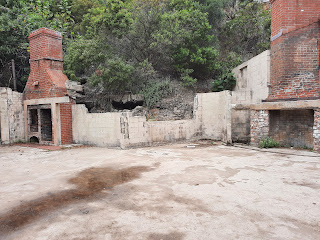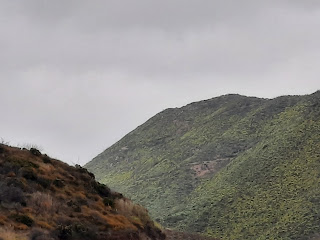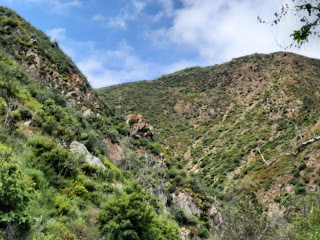Week 1, 5/24/23 - 5/27/23
My first day of work was Wednesday, 5/24, I was given Monday and Tuesday off to recover from the jet lag and then on Wednesday it was right to work. I began my day at 8:00 AM where Ranger Jessica Cooper picked me up to show me to headquarters. At headquarters I was introduced to Generalist Ranger Lorena Sanchez, who would be giving me my orientation. Ranger Sanchez took me all around the Santa Monica Mountains and gave me a brief tour. First, we stopped at the visitor center at King Gillette Ranch, a property that was once owned by King C. Gillette, the inventor of the disposable razor. After a brief visit to Paramount Ranch which was previously owned by Paramount Studios and has been the site of several films, we arrived at Solstice Canyon. Ranger Sanchez drove us a bit further down one of the driveways to the ruins of the Robert’s house. The house was built in 1952 and is located next to the waterfall, however, it burned down in a wildfire in recent years. After that we were on our way to Zuma and the Trancas Canyons where we did a brief driveby. Next stop was Rancho Sierra Vista, where Ranger Sanchez showed me the horse stables, the plant nursery and the Satwiwa Native American Indian Culture Center. Cheeseboro was our next stop, we just drove through the area, and then stopped for a few minutes at Rocky Oaks and Franklin Canyon. We briefly stopped by Peter Strauss Ranch which was named after the famed actor Peter Strauss. The only area I didn’t get to see was Circle X Ranch but that was only because I was meant to be back at Diamond X Ranch by 4:00 PM and time was running out.
Thursday and Friday, I was stationed at the visitor center at King Gillette Ranch. I arrived a few minutes before 9:00 AM and was introduced to Ranger Jazmin Ramsey and volunteer Russ. I spent the days learning about the history of the ranch and how to direct visitors to a hiking trail that suits their needs. King Gillette Ranch contains a visitor center, a mansion, a dormitory and a mess hall.
King Gillette purchased the property in 1926 and had the mansion as his retirement home. After he died, his widow sold the mansion to Clarence Brown, a MGM movie director. When he retired in 1952 the property again changed hands to a Catholic Brotherhood known as the Claretians. The Claretians constructed the three story dormitory and the mess hall. In 1986, Soka University in Japan purchased the ranch to establish a language school, but then sold it to the Mountains Recreation and Conservation Authority (MRCA) in 2005. This organization partnered with the National Park Service to create a visitor center and open the ranch for public use.
Saturday, I was assigned to work at the Satwiwa Native American Indian Culture Center at Rancho Sierra Vista, supervised by Ranger Caitlin Kouba. My day was pretty quiet since we don’t get a lot of visitors at the culture center and most people just want to use the restroom or refill water bottles. The Satwiwa Culture Center is a place where visitors can learn about the Chumash Native Americans, who inhabited most of southern California before American settlers pushed them off their land. The Chumash constructed many large and small villages in the mountains and along the coast, most of their tools were made from Yucca, a plant native to the area with a strong, versatile stalk. Currently, the Chumash are not recognized by the federal government and are engaged in a tense legal battle for sovereignty.
A few memories from this week include:
In the KGR visitor center we have a taxidermy mountain lion that was hunted in the 1970’s when hunting was still legal, the hunter had it taxidermized and when he died his widow donated it to us. A visitor came in and asked one of our volunteers if the NPS killed the mountain just to put it on display. The volunteer explained the anecdote above, but the visitor seemed unsatisfied and continued to lecture the volunteer on how it’s cruel and wrong for the park to kill a mountain lion and use it for decoration. After about ten minutes, the visitor left. That incident reminded me that this job requires much grace and patience
At Satwiwa, I was taking a walk through the garden with a volunteer when a cyclist stopped us and reported an unconscious cyclist about a mile down the trail. I ran to tell Ranger Kouba who was quick to call 911. She asked me where the reporter of the emergency was but I let him ride away so I ran about halfway down the trail trying to find him, I was unsuccessful. Thankfully, two more cyclists approached me and asked if I heard about the unconscious cyclist, I kept them around to ask further questions. The cyclist had his friend with him, he didn’t appear to be bleeding, and it seemed as though he was having an internal medical emergency. EMS units arrived soon, and took the cyclist away.
At Satwiwa, a young woman came in with her phone on one of those portable tripods that keeps your phone steady while you film. She walked around the culture center for about two minutes and then left. I could not believe that I had seen a real life influencer at work. This young woman was dressed in very fashionable workout clothes and had her hair and makeup done, which isn’t incredibly uncommon. But, I really knew I had spotted an influencer when I observed her filming everything she saw and her male companion carrying both his and her belongings.
At Satwiwa, a gentleman came in and told us that he saw a young family down at the creek catching newts to take home, which is not permitted as all wildlife in Santa Monica Mountains is protected. Ranger Kouba intercepted the family as they were leaving and got the newt. After we closed the culture center Ranger Kouba and I hiked out to the creek to return the newt home.







Comments
Post a Comment